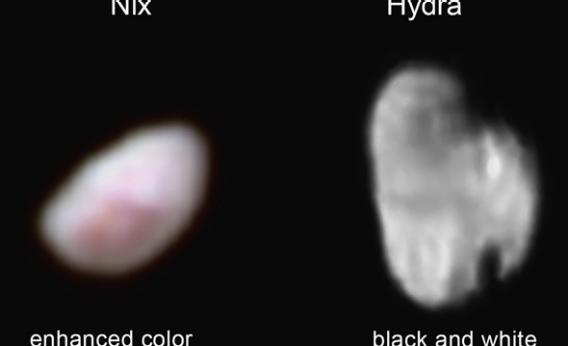Create a free profile to get unlimited access to exclusive videos, sweepstakes, and more!
More Pluto! And Two Weird Moons. Well, It’s All Weird. It’s Pluto.

On Tuesday, the folks at New Horizons released more images, this time of Pluto’s surface and two of its smaller moons, Nix and Hydra.
The Pluto image shows an area to the west of Tombaugh Regio, the heart-shaped pattern. Like the earlier release, this shows mountains surrounded by flat plains of ice. The mountains aren’t as tall as in the other area (1–1.5 kilometers high, as opposed to more than 3 kilometers), but there’s something new in this one: craters.
Unlike the first close-up showing no craters at all, here you can see circular features that look very much like old impacts filled in by ice. This lends credence to the idea that the mountains are old, and the plains younger, possibly due to something that flooded (or seeped) into the lower topography. You can really see where the older, darker material had the younger, brighter stuff fill in the lower areas.
Finding craters is very important, as that helps geologists figure out just how old the surface is; more craters means the surface has been out there for longer, exposed to space.
I can’t wait to see detailed spectra of the surface so that we can know why some places are dark and some bright. Spectra will give more information on the composition of the surface.
I have to note: Some of the craters well inside the dark region have bright floors, as if some of the material got in there as well. That’s a bit harder to explain with just flooding or seepage. I can almost see gullies leading to them … but the resolution is just barely too low to tell.
Patience.
This next shot shows the moons Nix and Hydra. Displayed roughly to scale, Nix is about 42 x 36 kilometers in size, and Hydra is 55 kilometers long. The best images we saw before were very pixelated, so these are fascinating to see.
Nix is red! Or it has a big red spot. It appears to be whiter near the edges, but I can’t be sure if that’s a real border to the spot or an odd effect caused by the curve of the moon’s horizon (note that the red hue in the photo has been amplified in processing to show it better). Either way, it’s a sure sign that some chemistry has been going on there. How?
Methane is abundant in the outer solar system. On Earth it’s fragile; in the presence of oxygen it’s easily burned (one reason it makes a useful fuel), forming carbon dioxide and water. But in the absence of oxygen, like out Pluto's way, ultraviolet light from the Sun can break down the molecule, and instead of forming water and CO2 it can build up to make more complex molecules. Called tholins, these are reddish in hue, and we see that a lot past Neptune.
The question is, why isn’t everything out there red? Pluto is reddish, but the big moon Charon is not. These are all clues telling us about the history of these objects. Were some objects more abundant in methane than others, or did something happen over millions of years to rob (or overfill) methane (or tholins) from some and not others? I’m totally guessing here. It’ll be interesting to see what the experts can tease out of the data.
The Hydra image, though not in color, is equally interesting. The moon is irregular in shape, looking like it has a huge bump on one end. I wonder though: That dark spot on the upper right might just be a big depression, and the rest of the bump in shadow. Perhaps more images will give us a better idea of the shape.
Two big craters are obvious; the one at the top (with a bright spot, probably a specular reflection—a glint—of sunlight off something shiny like ice) and the dark one at the bottom. I think at the bottom, that part of the moon is flattish and edge-on to the Sun; a possible crater rim can be seen on its left, and that would explain why the floor is in complete darkness. The crater on top is angled more toward us and the Sun, allowing sunlight into it.
Again, just seeing those craters is important. The more bodies we see with them, the better we can do at estimating their ages. How old is old, how young young? A hundred million years, a billion?
As usual, the first images of an unexplored place raise more questions than yield answers. But as we get more photos from New Horizons, we’ll see more of this territory and in higher resolution, too. The fun in the mystery isn’t in knowing the answer, it’s in finding it.
We’re on that journey now.


























